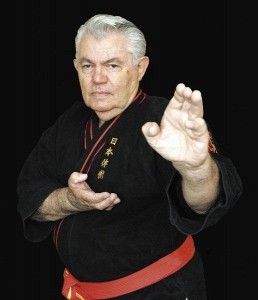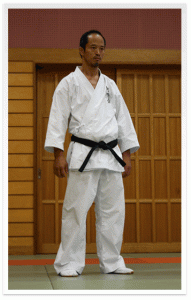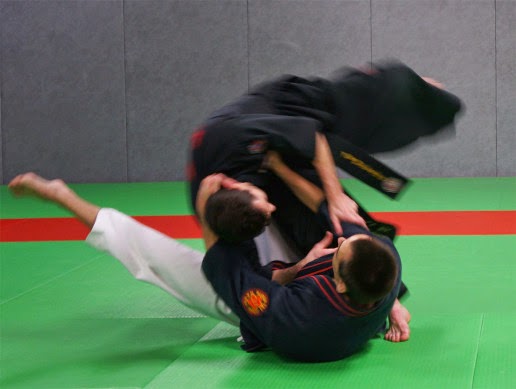Originally published on January 30, 2015 on Paresse Martiale
Today, the interview I propose is that of a practitioner at the other end of the world, lying in a pretty unique cultural context (for his practices, but not only).
His words reflect his opinion and perception of things (and this is the purpose of an interview).
[Paresse Martiale] Hello Xavier. As with Dan , we met via the late Kwoon.info forum, and are both members of the Kwoon.org forum. For those who do not read it (and even for those who do), and who do not know your blog, Tribulations Martiales, could you introduce yourself to the readers of this blog?
Hi, my name is Xavier and I have indeed been part of the Kwoon community since 2005 although I’m not very active. I have been living in Hong Kong since 2008 and teach Nihon Tai Jitsu, of which I am 4th dan. In parallel, my practice is focused towards how to use the body especially via Akuzawa sensei’s Aunkai that I have been practicing for 5 years, and yoga.
I started martial arts in 1998 with Nihon Tai Jitsu, probably for the wrong reasons, because I wanted to learn to defend myself and to become a black belt. I stayed because I discovered extremely rich practices, both physically and culturally as well as amazing people.
[PM] You teach Nihon Tai Jitsu , discipline little known of the general public in Hong Kong. Singular situation … Can you describe this discipline, its characteristics?
If the discipline is relatively little known in France, I let you imagine how confidential it can be here, France historically being the anchor of the school.
As a matter of fact, in 1951, Minoru Mochizuki, student of Jigoro Kano and Morihei Ueshiba, came to France to demonstrate Judo (he finally did not demonstrate much Judo, not to compete with Kawaishi sensei) and Aikido (that he taught under the name of Aikido-Jiujitsu ). Following his stay, one of his students, Jim Alcheik, left to Japan to study at his dojo in Shizuoka from 1954 to 1957. /back to France, he founded the French Federation of Aikido, Tai Jitsu and Kendo to transmit what he learnt.

Following the tragic death of Jim Alcheik in 1962 in an attack in Algeria, Roland Hernaez took over the tai jitsu part. We owe him the structure of the method. Nihon tai jitsu is an art that comes straight from Mochizuki sensei, but with a western way of teaching, especially with the introduction of kata groups and basic techniques.
Nihon Tai Jitsu is a method of tai jutsu, hence practiced exclusively with bare hands. Tai sabaki (movements) and te-hodoki (release of the hand) are preferred, there are no blocks, strictly speaking, as absorption, dodging and deviations are preferred. In terms of techniques used, the school curriculum is balanced between strikes, locks, throws, chokes and the famous sutemi of Mochizuki sensei’s Yoseikan.
[PM] How is teaching your discipline perceived, according to you, in your geographic and cultural context? Do you perceive differences (or similarities) with what you can do in France?
Teaching a Japanese discipline in Hong Kong is a relatively complex exercise. Unlike France where supply and demand are particularly strong for martial arts, this is not the case here. There are only a handful of Aikido dojos for example, and I believe we are the only one of jujutsu, yet on a territory of 8 million inhabitants. Worse, most people are surprised that there is a jujutsu other than Brazilian. Let’s say I’m starting with some handicaps here.
On the contrary, Brazilian Jiu-Jitsu and Muay Thai are very present as well as Taekwondo for children. Not to mention of course Chinese arts, including Wing Chun helped by the many films about Yip Man.
Overall, compared to France, there is a real lack of interest for this type of practice. The national sport is shopping and having a large group is difficult. Also because we do not have the support available in France: municipal halls, associations, forums, seminars, local press, etc. Getting known in these conditions remains a challenge.
[PM] Keeping one’s teaching alive is always difficult, especially when isolated from the sources: How do you enrich your own?
It’s difficult, but it became something natural to me. I only spent 5 years in a Nihon Tai Jitsu dojo before finding myself alone. When I was still living in France, I tried to compensate by spending all my weekends in seminars or practicing other disciplines. That’s how I discovered Hankido, a Korean art I practiced until 1st dan.

Arriving in Hong Kong it was more complicated because attending seminars was no longer possible. Failing jujutsu, I started Arnis and BJJ and I traveled to meet people who interested me, including Fred Evrard of Kali Majapahit in Singapore and Ko Young Baek of Hankido in Seoul. I was still in a perspective of “compensation” and I thought that learning styles and hundreds of techniques was the solution. But above all, in Hong Kong, I met another guy from Kwoon, Fred, and this encounter may be the one that helped me the most. First, because we started training together and he encouraged me to go to Tokyo and discover Aunkaï. Also because he’s the one who pushed me to take grading examinations and to start teaching. For about two years we trained exclusively together, without complacency and trying to keep the greatest possible objectivity in our practice. It was not easy to get out of our illusions but it has been extremely rewarding.
In late 2009, I started to get interested in the formation of the body, eventually leaving techniques accumulation aside. I started yoga, which my stiff body really needed, and early 2010 we went to Tokyo to begin Aunkaï. It was a one-way trip for me and I really committed myself in this direction.
A year later, Fred unfortunately left to Taiwan, and I started Aikido because I felt the need to have training partners and that was ultimately what was closest. A little frustrate, I finally opened a Nihon Tai Jitsu class in parallel, to find partners and continue to train in the direction that interested me.
Today I continue to teach Nihon Tai Jitsu and to practice Aikido, Yoga and Aunkai, my days are pretty busy. If all this may sound very chaotic (and it is), I think my current practice is consistent and that all of these have ended up making sense. Paradoxically, it is being isolated that helped me to grow by going out of my comfort zone and seeking answers by myself.
[PM] As we have seen, you are not locking yourself in your practice. What disciplines (or what practitioners) most influenced you over the years?
I had the opportunity to meet many practitioners and try many disciplines over the years, but some have particularly impressed me. I did not necessarily spend a lot of time with each of them, and except for Akuzawa sensei, it would be wrong to say that I consider myself their student, but they have all ben an inspiration in their own way.

Akuzawa sensei was clearly my most memorable encounter. I met him at a time when I had learnt a lot but where my progress were in a dead end. Aunkaï was a revelation and clearly what gave meaning to everything else. This meeting was a real overhaul.
Washizu sensei also deeply affected me. Former assistant of Mochizuki sensei, he is now teaching in his former dojo in Shizuoka. He is the memory of what was the Yoseikan, hence the best example we can have to understand the sources of Nihon Tai Jitsu. He is probably the most generous and humble man I met. A model for all of us.
In Aikido, Leo Tamaki and Yannick Le Fournis are the ones who really touched me. While the practice of my teacher in Hong Kong was made of brute force and complacency, I discovered a very subtle Aikido, light while remaining extremely martial. They are also passionate practitioners, open minded and curious whose practices are constantly changing.
Last on the list is Maul Mornie, of Silat Suffian Bela Diri. I particularly like the way he moves, simple and natural, his verticality and the richness of his techniques. He also has a great sense of humor and is very accessible, which only makes it better.
There is no order in this list, they are just people I’ve had the chance to meet and who helped me move forward.
[PM] You were recently allowed to create an Aunkaï study group by Akuzawa sensei, founder of the discipline. Can you tell us a few words of this approach in terms of practice, and of course in terms of organization?
I have been training with Akuzawa sensei regularly for the last 5 years, and two years ago he told me to share what he showed me with my students, knowing that improving was difficult without partners. Last year we talked about it when he came to Hong Kong and he supported the idea of a working group. In fact, Aunkaï is the heart of my practice and what gives it meaning, it was logical for me to engage in this way.
In organizational terms, twice a month we do a specific Aunkaï training instead of a Nihon Tai Jitsu class, but other sessions maintain the same working principles and some exercises like push out. My teaching is clearly focused on the principles and on how to use the body, Nihon Tai Jitsu being the “visible” application.
[PM] What do you think, precisely, of the idea of building the body to go to the application (Aunkaï approach)?
I started training the opposite way, with a lot of applications used to understand the principles and form the body. The results have not been great, and this may be due to my chaotic journey or to a lack of thinking on my part. Today I am convinced that the accumulation of techniques does not make sense, because what matters is the body that executes them. When I try a technique on Akuzawa sensei, nothing works. However, he is capable of destroying my structure with techniques that do not respect any criteria such as angle, timing, speed, simply because his body becomes the technique.
This approach made me realize that the different techniques were the hundreds of possible applications of a handful of principles. Somehow, I think that’s what Mochizuki sensei was looking for when seeking what linked the various arts he studied. Today my students understand it faster than I did. After six months of practice one of them said, “I realized that you are always doing the same thing.” This remark filled me with joy.
[PM] What is the school or the practitioner you would like to test?
I am very curious and many things interest me. Today the two people I’d most like to meet are Kuroda sensei and Mikhail Ryabko. Two outstanding practitioners who use their bodies out of the usual standards. I do not know when it will happen, or even if their work is compatible with my current research, but I would really like the opportunity to touch and feel what they do.
[PM] Let’s get a bit away from the strict practice context. You’re blogging on martial arts like here, in fact, but older). What feedback can you give us?
I created my blog in 2008 to keep in touch with my martial arts friends who remained in France and to inform them of my evolution despite the distance. I have quickly developed a taste for it and even though few people read it, it remains a way for me to remember where I come from.
This blog is a diary of my personal thoughts at a T-time, and what I say one day can be completely reversed later. In this, it is at the image of my practice, constantly changing.
Paradoxically, it turned out that much more influential and talented people than me follow my blog and it helped to give me a relative visibility within the Nihon Tai Jitsu world. It was not my goal but I’m glad to know that my thoughts may be of interest and add a small stone to the edifice.
[PM] We arrive at the end of this interview. As I wrote in a previous interview, I like to finish these exchanges by asking two questions. The first is: what is your best memory of practice?
This is probably the most difficult question you have asked me … In almost 20 years of practice, many things happened and memories are incredibly numerous: from my black belt quickly given in the changing room to the amazing opportunity to represent my school in a demonstration at Kyoto’s Butokuden, through the great opportunity to travel around the world to follow my passion.
But if I had to choose something, I think it would be the human aspect and the sharing related to the practice: seeing my students improve and ask good questions is such an unbelievable pleasure. I also had the opportunity to give some courses in France and I am always touched to see people take an interest in what I do, and even to travel a few hundred kilometres to meet me. It’s not something I would have imagined, and sharing these moments is definitely what I enjoy most.
[PM] The second one is to know what you would like to convey to the reader?
Maybe three things that I think are important.
The first one is that one need to learn to keep an open mind. Meeting with practitioners from other disciplines is not scattering, it is accepting diversity and understand what we do and why we do it. Martial arts are exceptionally rich, there is so much to see and learn.
The second thing is to question yourself constantly. The practice is not linear, one must be able to put everything back in question constantly. It’s difficult, sometimes painful, but it’s the only way I found to get out of his comfort zone and grow technically and humanly.
The third thing is of course to have fun. Have fun training, but also take pleasure in sharing with other people and discovering new things. Beyond all the obstacles of life, relocation, work, family life, all that may go against training, do not give up if you love what you do. You can always move forward and take the same pleasure in conditions that are not ideal.
[PM] Thank you for the time you have spent answering me, and for the comprehensive answers. See you very soon!
Thank you. I realize how the interview exercise is a difficult one but it was a great opportunity to put my ideas back in place, and I thank you for proposing it to me. I also want to thank your readers if they were able to reach the end …
Thanking Xavier is the least I can do for this interview to which he responded very quickly with great care and kindness. Practice with him if you go to Hong Kong.
